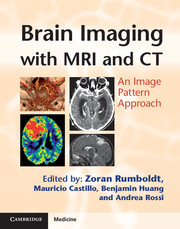Book contents
- Frontmatter
- Contents
- List of contributors
- List of abbreviations
- Preface
- Section 1 Bilateral Predominantly Symmetric Abnormalities
- 1 Hepatic Encephalopathy
- 2 Neurofibromatosis Type 1 – UBOs
- 3 Carbon Monoxide Intoxication
- 4 Pantothenate Kinase-Associated Neurodegeneration (Hallervorden–Spatz Syndrome)
- 5 Methanol Intoxication
- 6 Wilson Disease 12
- 7 Hypoxic Ischemic Encephalopathy in Term Neonates
- 8 Cryptococcosis
- 9 Gangliosidosis GM2
- 10 Leigh Disease
- 11 Deep Cerebral Vein Thrombosis (DCVT)
- 12 Creutzfeldt-Jakob Disease (CJD)
- 13 Global Cerebral Anoxia in Mature Brain
- 14 Wernicke Encephalopathy
- 15 Amyotrophic Lateral Sclerosis
- 16 Glutaric Aciduria Type 1
- 17 Subcortical Band Heterotopia
- 18 Bilateral Perisylvian Polymicrogyria (BPP)
- 19 Lissencephaly
- 20 Herpes Simplex Encephalitis
- 21 Limbic Encephalitis
- 22 CADASIL (Cerebral Autosomal Dominant Arteriopathy with Subcortical Infarcts and Leukoencephalopathy)
- 23 Megalencephalic Leukoencephalopathy with Subcortical Cysts
- 24 Canavan Disease
- 25 HIV Encephalopathy
- 26 Radiation- and Chemotherapy-Induced Leukoencephalopathy
- 27 Leukoaraiosis (Microangiopathy)
- 28 Periventricular Edema in Acute Hydrocephalus
- 29 Hypoglycemia
- 30 X-Linked Adrenoleukodystrophy (X-ALD)
- 31 Periventricular Leukomalacia (PVL)
- 32 Posterior Reversible Encephalopathy Syndrome (PRES, Hypertensive Encephalopathy)
- 33 Alexander Disease
- 34 Metachromatic Leukodystrophy
- 35 Neurodegenerative Langerhans Cell Histiocytosis (ND-LCH)
- 36 Remote Cerebellar Hemorrhage
- 37 Spontaneous Intracranial Hypotension
- Section 2 Sellar, Perisellar and Midline Lesions
- Section 3 Parenchymal Defects or Abnormal Volume
- Section 4 Abnormalities Without Significant Mass Effect
- Section 5 Primarily Extra-Axial Focal Space-Occupying Lesions
- Section 6 Primarily Intra-Axial Masses
- Section 7 Intracranial Calcifications
- Index
- References
21 - Limbic Encephalitis
from Section 1 - Bilateral Predominantly Symmetric Abnormalities
Published online by Cambridge University Press: 05 August 2013
- Frontmatter
- Contents
- List of contributors
- List of abbreviations
- Preface
- Section 1 Bilateral Predominantly Symmetric Abnormalities
- 1 Hepatic Encephalopathy
- 2 Neurofibromatosis Type 1 – UBOs
- 3 Carbon Monoxide Intoxication
- 4 Pantothenate Kinase-Associated Neurodegeneration (Hallervorden–Spatz Syndrome)
- 5 Methanol Intoxication
- 6 Wilson Disease 12
- 7 Hypoxic Ischemic Encephalopathy in Term Neonates
- 8 Cryptococcosis
- 9 Gangliosidosis GM2
- 10 Leigh Disease
- 11 Deep Cerebral Vein Thrombosis (DCVT)
- 12 Creutzfeldt-Jakob Disease (CJD)
- 13 Global Cerebral Anoxia in Mature Brain
- 14 Wernicke Encephalopathy
- 15 Amyotrophic Lateral Sclerosis
- 16 Glutaric Aciduria Type 1
- 17 Subcortical Band Heterotopia
- 18 Bilateral Perisylvian Polymicrogyria (BPP)
- 19 Lissencephaly
- 20 Herpes Simplex Encephalitis
- 21 Limbic Encephalitis
- 22 CADASIL (Cerebral Autosomal Dominant Arteriopathy with Subcortical Infarcts and Leukoencephalopathy)
- 23 Megalencephalic Leukoencephalopathy with Subcortical Cysts
- 24 Canavan Disease
- 25 HIV Encephalopathy
- 26 Radiation- and Chemotherapy-Induced Leukoencephalopathy
- 27 Leukoaraiosis (Microangiopathy)
- 28 Periventricular Edema in Acute Hydrocephalus
- 29 Hypoglycemia
- 30 X-Linked Adrenoleukodystrophy (X-ALD)
- 31 Periventricular Leukomalacia (PVL)
- 32 Posterior Reversible Encephalopathy Syndrome (PRES, Hypertensive Encephalopathy)
- 33 Alexander Disease
- 34 Metachromatic Leukodystrophy
- 35 Neurodegenerative Langerhans Cell Histiocytosis (ND-LCH)
- 36 Remote Cerebellar Hemorrhage
- 37 Spontaneous Intracranial Hypotension
- Section 2 Sellar, Perisellar and Midline Lesions
- Section 3 Parenchymal Defects or Abnormal Volume
- Section 4 Abnormalities Without Significant Mass Effect
- Section 5 Primarily Extra-Axial Focal Space-Occupying Lesions
- Section 6 Primarily Intra-Axial Masses
- Section 7 Intracranial Calcifications
- Index
- References
Summary
Specific Imaging Findings
In limbic encephalitis (LE), the mesial temporal lobes show bright T2 signal and may appear swollen or of normal width. Contrast enhancement is commonly absent, but when present may be patchy or have a bizarre configuration and distribution. About 50% of patients show bilateral involvement, often asymmetrical. The lesion may extend from the amygdala to the tail of the hippocampus. Other areas which are occasionally involved include the parahippocampal gyrus, temporal white matter stem, thalamic pulvinar, dentate nuclei and cerebellar cortex. With the passage of time, the signal abnormality resolves (although not completely in many patients) and the affected area loses volume. ADC measurements have been inconclusive and thus not helpful, while high signal intensity in DWI is thought to be due to shine-through phenomenon. Proton MR spectroscopy may show low n-acetylaspartate, normal choline and occasionally high glutamate/glutamine and lactate. In some patients, all metabolites are low.
Pertinent Clinical Information
Symptoms tend to start relatively acutely and include: cognitive dysfunction, recent memory difficulties, hallucinations, bizarre behavior, seizures, sleep disturbances, and speech disturbances. Symptoms are present in about 80% of patients who have an abnormal MRI study. The symptoms may be similar to those seen in Alzheimer and Creutzfeldt–Jakob diseases but their more acute onset and the presence of underlying neoplasias helps differentiate among them. To make the diagnosis, CSF must be free of malignant cells, viruses and other pathogens.
- Type
- Chapter
- Information
- Brain Imaging with MRI and CTAn Image Pattern Approach, pp. 43 - 44Publisher: Cambridge University PressPrint publication year: 2012

